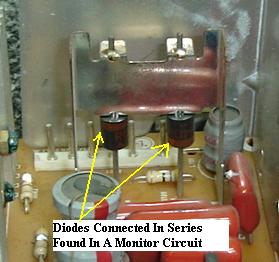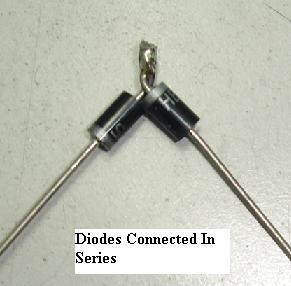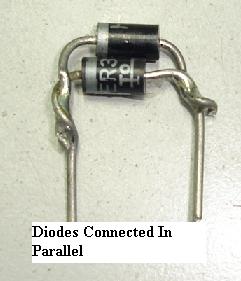Finding A Diode Replacement With The Help Of Diodes In Series And Parallel Method.
This little ‘extra time’ sometimes may take you longer than an hour. Forums usually take couples of hours to days to give you the answer.
Worst case, if there are no answer from the forum and the equipment you repair lying down the corner of the technical department waiting for you to settle it-sound familiar? Even if your electronic suppliers have the part, you will again wasting your time purposely drive to town just to get that part only. If your customer can wait then there will be no problem and what if the customers want it fast?
When talks about diode specification, one always refer to peak reverse voltage (PRV) and ampere (A). Assuming you have a diode with the spec of 800V 2A and you want to find a replacement. You can always use diodes connect in series method to get the desire spec.
For example, two 400V 2A diodes connect in series will get you 800V 2A. You can always use this method for replacement but to make the diodes last longer you have to connect a resistor and a capacitor and place across each diode to equalize the PRV drops and guard against transient voltage.
In order to find the resistor value, as a rule of thumb, multiply the PRV rating of the diodes by 500 ohms. For example, an 800 PRV diode should be shunted by 800 X 500 equal to 400,000 ohms. As for the capacitor value, use a 0.01 microfarad ceramic disc capacitor connected across each diode.
Now, if you have a 400V 10A diode that needs replacement, you may use the diodes connect in parallel method to get the desire spec. Connect two 400V 5A in parallel and you will get 400V 10A. From experienced, if possible try to find or get the exact or equivalent part number first before using the above method. Hope this article can cut short your repair time. Have a good day!
|
|
Copyright@ 2006-2014-www.ElectronicRepairGuide.com All Rights Reserved
 Troubleshooting tough dog (difficult to repair) problems consumed you lots of time and another problem that take you lots of time
is to locate the original spare part numbers. You may take couple of minutes to find a bad components but because of no spare parts
available in your component’s compartment, then you will need some extra time to find it such as to call up your electronic suppliers,
finding your semiconductor data book for specification and replacement, searching the internet for the particular component data hope to get
an exact substitution and some of you may visit forum to ask for an answer.
Troubleshooting tough dog (difficult to repair) problems consumed you lots of time and another problem that take you lots of time
is to locate the original spare part numbers. You may take couple of minutes to find a bad components but because of no spare parts
available in your component’s compartment, then you will need some extra time to find it such as to call up your electronic suppliers,
finding your semiconductor data book for specification and replacement, searching the internet for the particular component data hope to get
an exact substitution and some of you may visit forum to ask for an answer. In today’s article I’m going to show you how you can use diodes to connect either in series or parallel to get the desire volts
and ampere for replacement assuming that there is no way you can find the original part number.
In today’s article I’m going to show you how you can use diodes to connect either in series or parallel to get the desire volts
and ampere for replacement assuming that there is no way you can find the original part number.